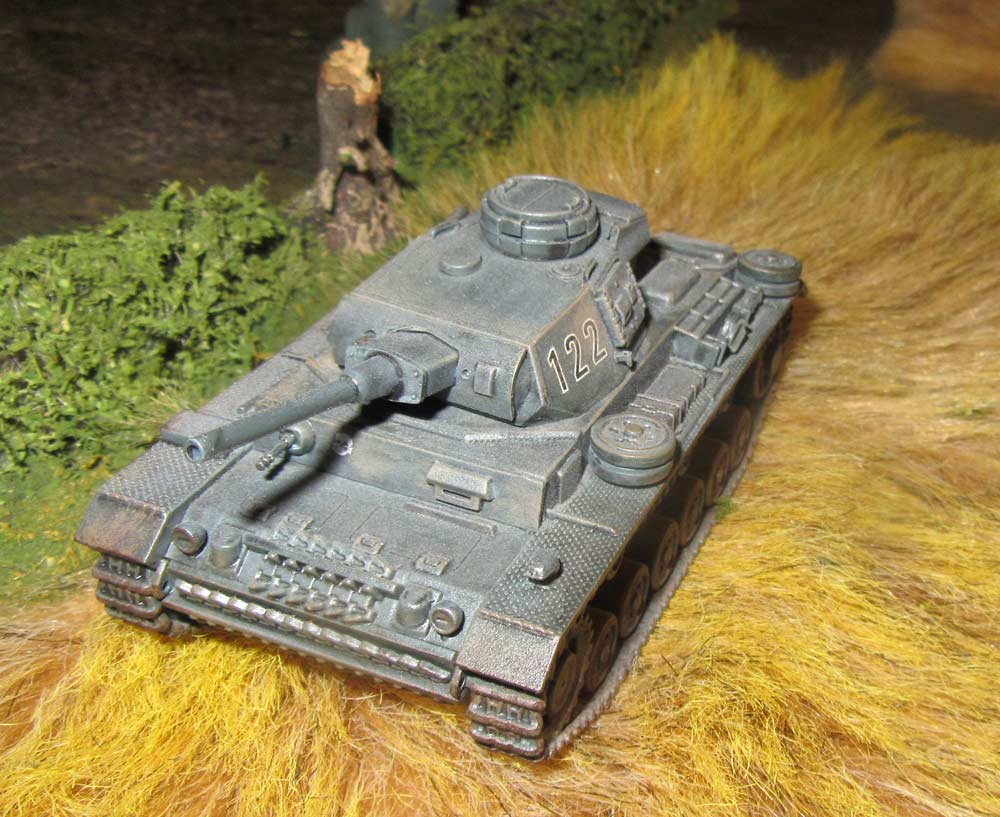
Attack on Warlaing 1940
1st May 2021, 0 Comments
Second World War, Chain of Command, 28mm
This game, played at home, had to correspond to all Covid restrictions, so this were a little limiting. Still, I was able to play facemask-to-facemask as it were, and this is the result. My friend Lindsay wanted to field her 1940 Germans, so I dug out my early war British, and laid on a game. This fight was taken from a “Pint-Sized Campaign” in the Too Fat Lardy’s Lard Magazine 2018 called Many Rivers to Cross” . We set it in Northern France to the north-west of Valenciennes in late May 1940. 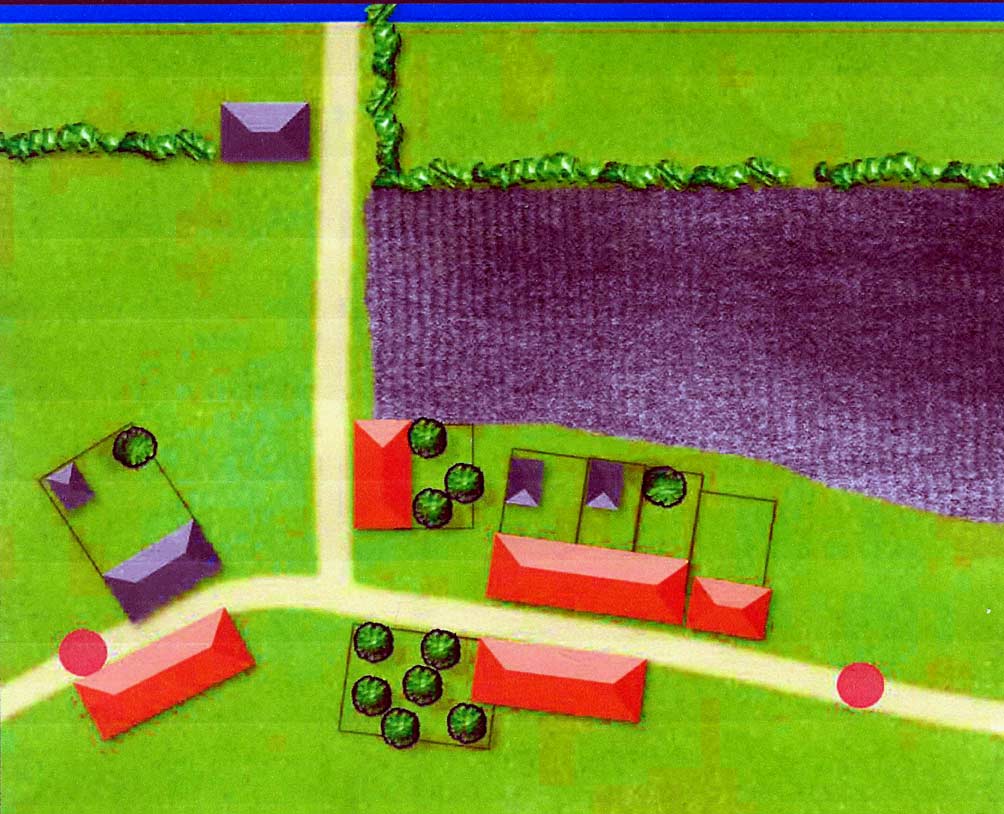 The premise was that the Germans had established a bridgehead over the River Scarpe upriver from Marchiennes. The German advanced guard then tried to expand the bridgehead by capturing the nearby village of Warlaing. it though, was held by a British infantry platoon, who were waiting and ready for them. The game was played out on an 6×4 foot table, with the Germans attacking from the southern (blue) long table edge – the direction of the river and their bridgehead. The British deployment points were marked by the red dots.
The premise was that the Germans had established a bridgehead over the River Scarpe upriver from Marchiennes. The German advanced guard then tried to expand the bridgehead by capturing the nearby village of Warlaing. it though, was held by a British infantry platoon, who were waiting and ready for them. The game was played out on an 6×4 foot table, with the Germans attacking from the southern (blue) long table edge – the direction of the river and their bridgehead. The British deployment points were marked by the red dots. 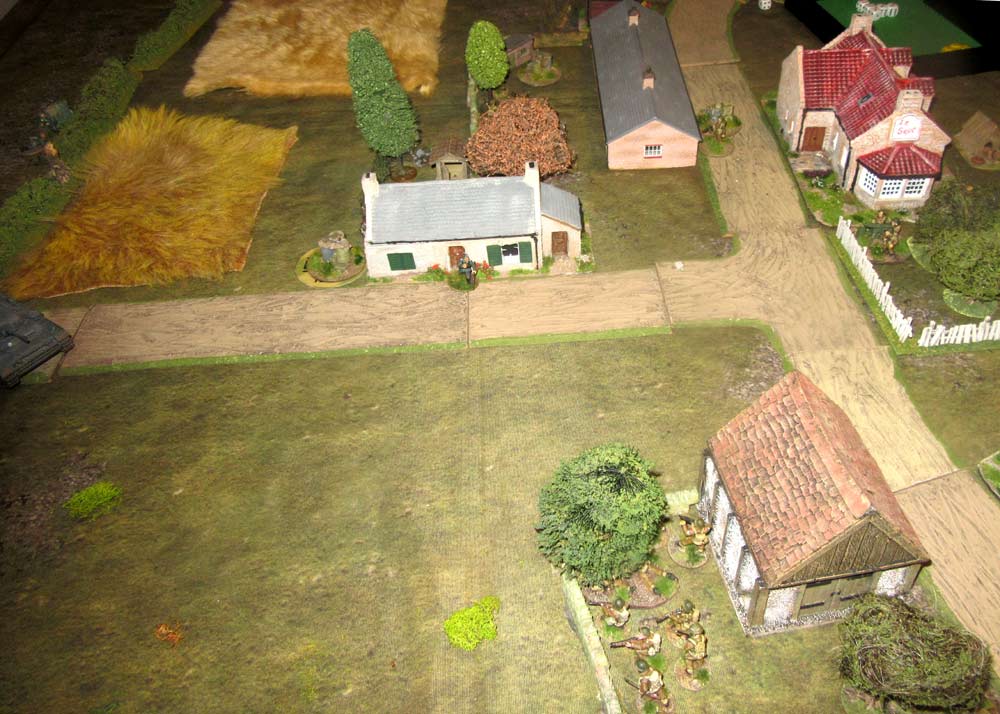 Lindsay commanded the Germans, while I took charge of the British, with the able assistance of Mally. We tried to stay faithful to the scenario, except the ploughed field had to be replaced by wheat, and the buildings looked a little different. Also, in the scenario, the Germans could only draw on man-portable support weapons. We ignored that though, as Lindsay was very keen to field a tank. Thanks to the difference in platoon ratings, then despite the fact that the Germans were attacking, both sides had roughly the same number of support points. Knowing a tank was in the offing, we blew ours on a 2-pounder AT gun, as well as a Vickers MMG.
Lindsay commanded the Germans, while I took charge of the British, with the able assistance of Mally. We tried to stay faithful to the scenario, except the ploughed field had to be replaced by wheat, and the buildings looked a little different. Also, in the scenario, the Germans could only draw on man-portable support weapons. We ignored that though, as Lindsay was very keen to field a tank. Thanks to the difference in platoon ratings, then despite the fact that the Germans were attacking, both sides had roughly the same number of support points. Knowing a tank was in the offing, we blew ours on a 2-pounder AT gun, as well as a Vickers MMG. 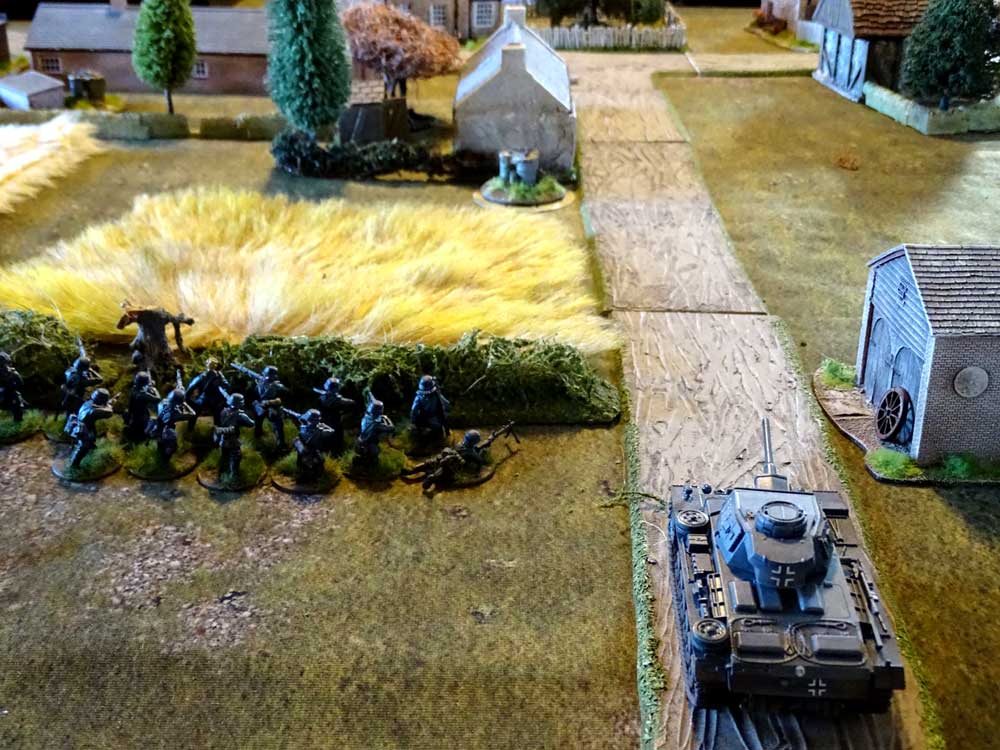 The Germans though, had a problem. There was a lot of open ground to cross, and so Lindsay, a CoC newbie, was hesitant to cross it. So, she tried to use her superior firepower to grind us down. We gave as good as we got though, and by deploying two infantry sections, one on each side of the road into the village, we were able to do most of the grinding. Lindsay actually had a toe-hold in the village – a jump-off point just behind the cottage on the roadside, at the edge of the village. She planned to deploy there, but first she brought her tank on, to soften things up.
The Germans though, had a problem. There was a lot of open ground to cross, and so Lindsay, a CoC newbie, was hesitant to cross it. So, she tried to use her superior firepower to grind us down. We gave as good as we got though, and by deploying two infantry sections, one on each side of the road into the village, we were able to do most of the grinding. Lindsay actually had a toe-hold in the village – a jump-off point just behind the cottage on the roadside, at the edge of the village. She planned to deploy there, but first she brought her tank on, to soften things up.  This was quite a beast – much more useful than our puny 2-pounder. Still, we stayed hidden and hoped for a good, telling shot. As the tank advanced, the infantry firefight continued, while Lindsay deployed her second squad near that cottage. She had to get into it first though, which is when she started taking real casualties, first from Mally’s section to the east, and then my Vickers, hidden in an orchard to the north. The rest of the German platoon though, made it into the cottage, where they could fire on the flank of my section in the western side of the village.
This was quite a beast – much more useful than our puny 2-pounder. Still, we stayed hidden and hoped for a good, telling shot. As the tank advanced, the infantry firefight continued, while Lindsay deployed her second squad near that cottage. She had to get into it first though, which is when she started taking real casualties, first from Mally’s section to the east, and then my Vickers, hidden in an orchard to the north. The rest of the German platoon though, made it into the cottage, where they could fire on the flank of my section in the western side of the village.  To break the deadlock, Lindsay advanced her tank down the road, to support the squad in the cottage. That’s when I revealed my 2-pounder, which did its best. I rolled well, but with a net two hits all I managed to do was to kill the driver. The tank commander hauled his body out of the way and stuck the tank in reverse. It hightailed it off the road, and out of my arc of fire. The tank sat there for a round or two, as the crew recovered from the shock, so meanwhile the infantry fight continued.
To break the deadlock, Lindsay advanced her tank down the road, to support the squad in the cottage. That’s when I revealed my 2-pounder, which did its best. I rolled well, but with a net two hits all I managed to do was to kill the driver. The tank commander hauled his body out of the way and stuck the tank in reverse. It hightailed it off the road, and out of my arc of fire. The tank sat there for a round or two, as the crew recovered from the shock, so meanwhile the infantry fight continued.  I still kept taking casualties to the west of the village, mainly from the MG-34 set up in the cottage, but on the whole the combined fire from my section and Mally’s one did the trick. Eventually, the German squad facing us broke and pulled back. I’d like to say it was because the Germans were suffering from hiding behind a hedge, while we had stouter stone walls. In truth though, it was Mally’s die rolling that turned the tide, and his section pictured above.
I still kept taking casualties to the west of the village, mainly from the MG-34 set up in the cottage, but on the whole the combined fire from my section and Mally’s one did the trick. Eventually, the German squad facing us broke and pulled back. I’d like to say it was because the Germans were suffering from hiding behind a hedge, while we had stouter stone walls. In truth though, it was Mally’s die rolling that turned the tide, and his section pictured above. 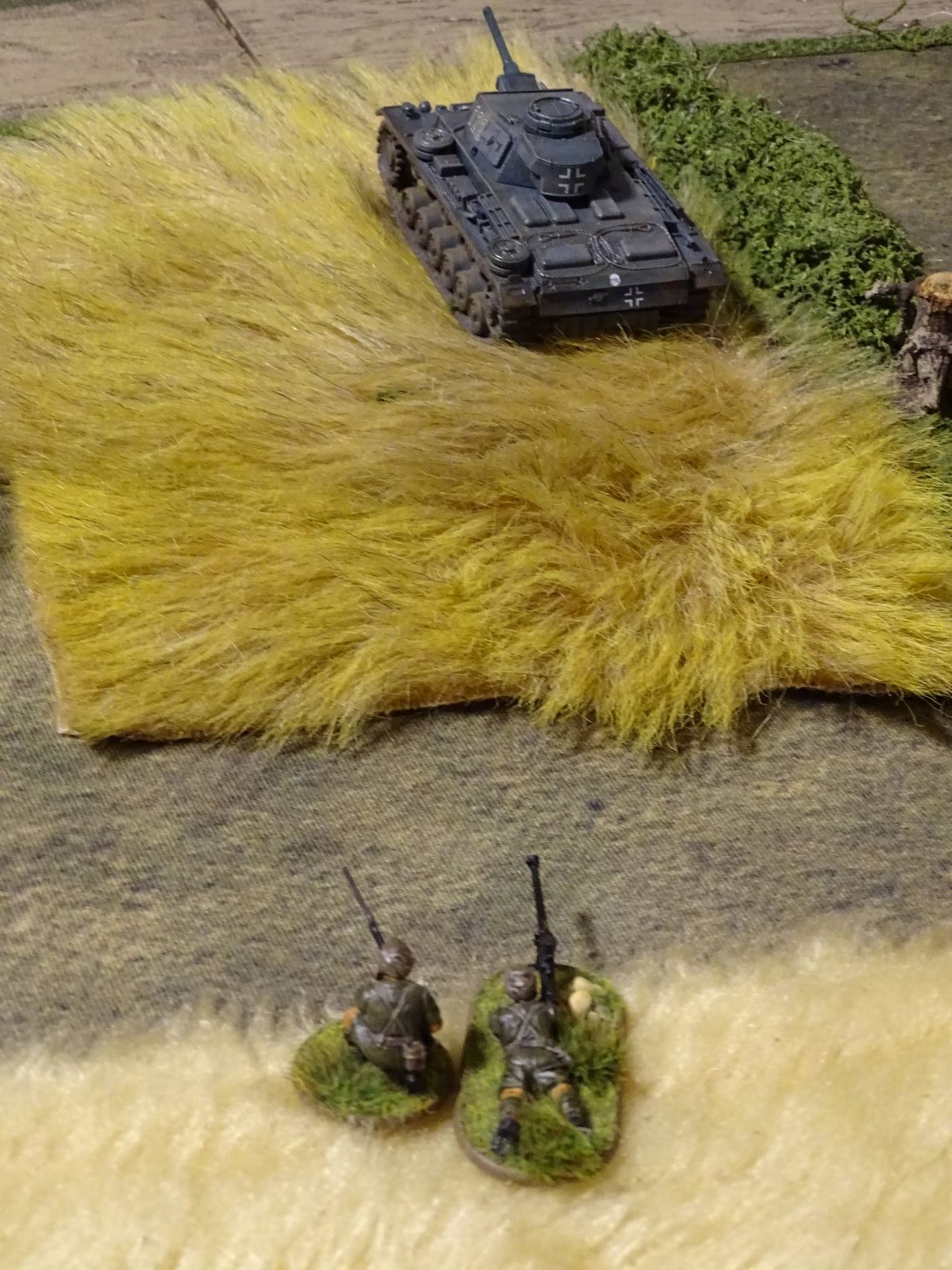 By then we’d racked up a CoC die, so I decided to spring an “ambush”. I stuck my Boyes AT gun in the cornfield, behind the Panzer III, and let fly. They did well, scoring two net hits, but this time it basically did nothing. Clearly I’d have to wait until someone invented a PIAT. So, my brave AT rifle team – a pair of Sikhs by the way (as I didn’t have my own figures), weren’t much use. Still, the upshot was that the Panzer stayed put, as compared to the 2-pounder they Sikhs were the lesser of two evils.
By then we’d racked up a CoC die, so I decided to spring an “ambush”. I stuck my Boyes AT gun in the cornfield, behind the Panzer III, and let fly. They did well, scoring two net hits, but this time it basically did nothing. Clearly I’d have to wait until someone invented a PIAT. So, my brave AT rifle team – a pair of Sikhs by the way (as I didn’t have my own figures), weren’t much use. Still, the upshot was that the Panzer stayed put, as compared to the 2-pounder they Sikhs were the lesser of two evils.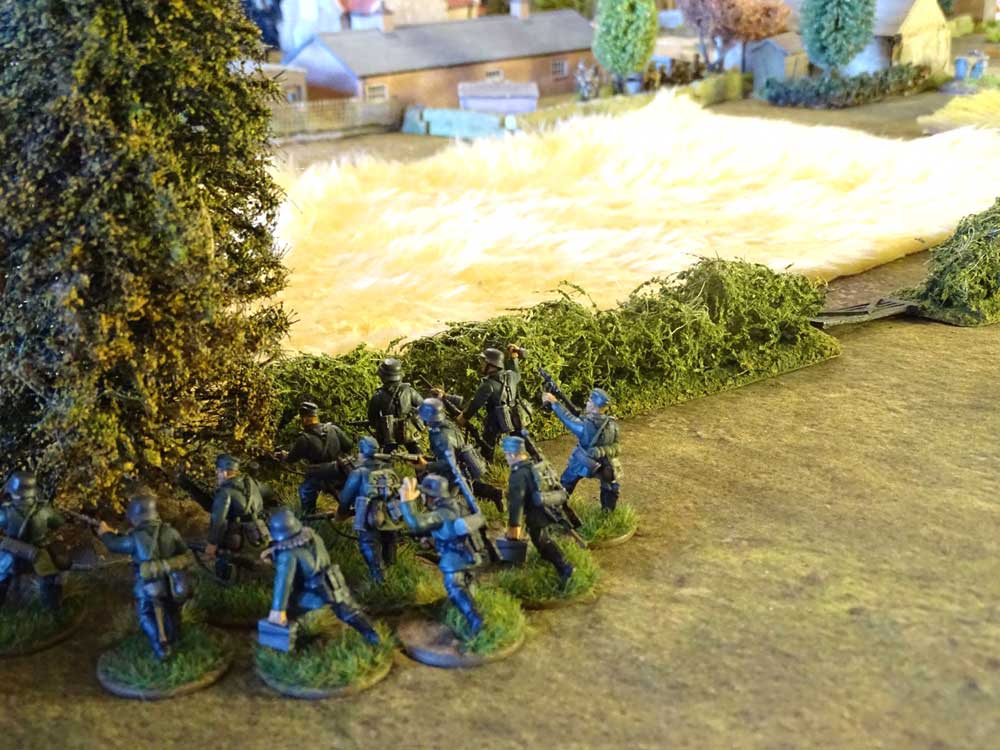 By now, Lindsay was running out of options. Clearly the attack down the road had stalled, so she deployed her last squad behind the hedge to the west of the town, covered handily my British 2-inch mortar smoke rounds, which I’d laid to protect myself from fire from another MG-34. She decided the only way to win was to head across the wheat field, covered by the smoke.
By now, Lindsay was running out of options. Clearly the attack down the road had stalled, so she deployed her last squad behind the hedge to the west of the town, covered handily my British 2-inch mortar smoke rounds, which I’d laid to protect myself from fire from another MG-34. She decided the only way to win was to head across the wheat field, covered by the smoke.  She stepped out bravely enough, while our now fairly concentrated fire picked off that MG-34. Our smoke, you see, had landed in the wrong place to protect us – and them. As the Germans advanced we played our next CoC die, and ended the turn. That did two things. First, it meant that the broken German squad w was lifted from the table. Second, the smoke cleared, giving us a clear line of fire on the advancing Germans.
She stepped out bravely enough, while our now fairly concentrated fire picked off that MG-34. Our smoke, you see, had landed in the wrong place to protect us – and them. As the Germans advanced we played our next CoC die, and ended the turn. That did two things. First, it meant that the broken German squad w was lifted from the table. Second, the smoke cleared, giving us a clear line of fire on the advancing Germans. We also deployed our last turn, clustered at the far west of the village, facing the advancing Germans. That, it turns out, gave us all the firepower we needed to mow down half of them, and send the rest running for home. The whole defence, by the way, was coordinated by Lieutenant Boothroyd (above), who spent the whole game hiding behind a row of cottages, and shouting orders to his men! Still, it meant he lived to tell the tale. With that though, the German morale dropped to Zero, and the game ended in a British victory. No doubt they’ll be back though, in another attempt to expand their bridgehead over the River Scarpe. I’m worried now, that the smoke might give Lindsay an idea about how best to cross open ground…
We also deployed our last turn, clustered at the far west of the village, facing the advancing Germans. That, it turns out, gave us all the firepower we needed to mow down half of them, and send the rest running for home. The whole defence, by the way, was coordinated by Lieutenant Boothroyd (above), who spent the whole game hiding behind a row of cottages, and shouting orders to his men! Still, it meant he lived to tell the tale. With that though, the German morale dropped to Zero, and the game ended in a British victory. No doubt they’ll be back though, in another attempt to expand their bridgehead over the River Scarpe. I’m worried now, that the smoke might give Lindsay an idea about how best to cross open ground…